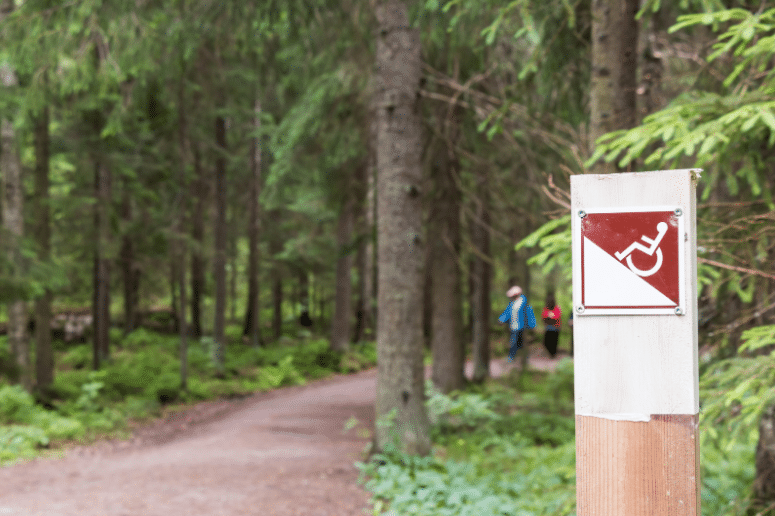

Inclusive Engineering: Designing Accessible Parks and Recreation Spaces for Everyone
Have you ever been to a park or trail and noticed that the space’s design was not accessible? While this thought may not occur to individuals without disabilities, it is a common realization for those who utilize wheelchairs, strollers, or similar methods for mobility. The lack of accessible designs in parks and recreation spaces can be frustrating and even polarizing for individuals with disabilities.
Fortunately, with the help of civil engineers and thoughtful designs, we can make parks and recreational outdoor spaces accessible to everyone. Let’s explore why engineering accessible and ADA designs are so important, and the ways in which engineers are helping create more inclusive public outdoor spaces.
Why are accessible designs in parks so important?
Accessible designs in parks and recreation spaces have many benefits, including:
- Improving the quality of life for people with disabilities
- Supplying better access to natural spaces for all
- Increasing economic development opportunities
- Promoting tourism activities
- Encouraging physical activity
- Reducing health disparities… beyond!
Sadly, not all parks are designed with accessibility in mind. Engineers play a key role in designing efficient pathways for users of all abilities — whether that means creating wheelchair ramps, wider paths or adding lights along trails. All of these improvements can make public spaces like parks more accessible for everyone.
In recent years, the concept of renovating public parks and recreation spaces to make them more accessible and inclusive has grown increasingly popular. Many cities have undertaken projects to ensure that public parks and recreational spaces are designed for everyone, regardless of their age, ability level, or economic status. By creating a space that provides access for people of all backgrounds and abilities, cities are actively encouraging residents to get outside and enjoy the outdoors with their friends and family in a safe environment.
Not only do these projects help encourage more equitable access for everyone who lives in the area, but they also help preserve our natural habitats by providing a protected space for wildlife and plants to co-exist with humans. Those seeking out recreational activities can take advantage of eco-tourism opportunities while still making sure not to disturb the surrounding ecosystems.
Furthermore, many cities have introduced initiatives aimed at encouraging individuals to get out into nature more often; this includes establishing volunteer programs where residents can help maintain existing parks or create new ones. Initiatives aimed at making trails and parks more accessible have also become more popular nationwide. These initiatives require a combined effort that includes all members of the community – from local government departments to small businesses, and most importantly – the local residents.
Take the example of Arch Street Park in Lawrenceburg, Indiana, where the Lawrenceburg community set out to revamp the park by forming the Arch Street Park Playground Committee in 2020, a committee that consisted of area residents, young students and community members. Without it, the project would not have been possible.
Important factors to consider when engineering accessible designs
When designing a more accessible public space, engineers must consider:
- Overall public safety
- Usability for everyone, particularly those with physical limitations
- Accessibility requirements (ADA requirements)
- Environmental impacts of engineering more accessible spaces
- Completing the project in the most sustainable way
- Potential liabilities associated with the space
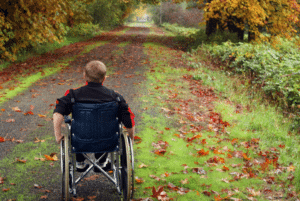
For example, when creating wheelchair ramps or installing lights along trails they must ensure the additions comply with applicable codes such as ADA regulations (Americans with Disabilities Act). Additionally, they must consider the type of environment they are working in.
Some questions an engineer may take in mind when designing more accessible spaces would be:
- Is it a coastal city or a mountain town?
- Is there extreme weather or terrain involved?
All these factors will influence the design process of an environmental or ADA design engineer in parks and rec.
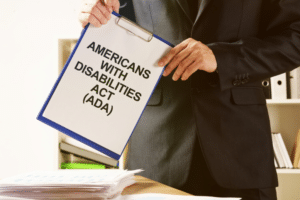
As engineers design outdoor public spaces to be more accessible for all, they are looking at a variety of solutions to make the space easier for all individuals to move through. For example, ramps and wider trails can help those with physical disabilities navigate more conveniently. Beach access can also be designed with wheelchair accessibility in mind. Engineers are creating beach accesses equipped with mats extending from the parking lot to the beach, allowing those with wheelchairs or other mobility devices to reach the sand without difficulty.
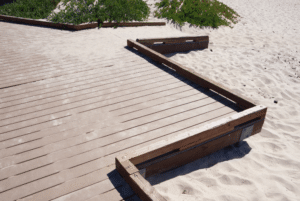
In addition, engineers in this realm are committed to creating designs that make play sets and playgrounds more accessible. This includes elevating ground levels, adding guardrails, and increasing ramp angles so that those in wheelchairs can easily maneuver around them. This may also include building these play sets closer together so that children in wheelchairs have a better chance of being able to interact with friends who don’t have disabilities.
Furthermore, some engineers might even consider adding sensory elements such as texture boards or sound pods to give children with sensory needs something stimulating and engaging when playing outdoors.
Engineers are also working on incorporating interactive displays and maps into outdoor public spaces so that visitors can get information about the area they’re visiting and how best to navigate it independently. These displays could be accessible via voice commands or by supplying options for both audio and visual output. Additionally, some parks might even consider installing tactile maps so visitors who are visually impaired may have an easier time familiarizing themselves with their environment.
Overall, there is a strong focus on engineering solutions that make outdoor public spaces accessible for all types of people regardless of ability level or disability status. This recent attention is resulting in increasingly innovative designs tailored towards creating an inclusive and safe experience for everyone.
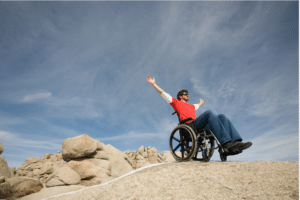
Final thoughts
Civil engineers play a key role in ensuring our public outdoor spaces remain accessible to everyone – regardless of their physical abilities. Engineers create thoughtful accessible designs by using advanced techniques and innovative technology to create efficient pathways that are safe and easy to navigate for people using wheelchairs or strollers. By engineering accessible designs, we can create inclusive public outdoor spaces that promote physical activity among users of all ages and abilities!
How Can Carroll Engineering Help Your Next Project?
Carroll Engineering Corporation is a professional Civil Engineering firm that services the Tri-State area. We engineer ADA-compliant designs and create innovative accessible designs for all types of spaces and places including parks and recreations facilities like playgrounds and trails. We also deliver highly regarded professional services including surveying, planning & site design, water facilities engineering, wastewater engineering, traffic & transportation engineering, municipal engineering and beyond to a wide range of municipal, public and private clients.
We have offices located in Warrington, PA (Bucks County), King of Prussia, PA (Montgomery County), Malvern, PA (Chester County), and Hillsborough, NJ (Somerset County). All our departments serve as valuable resources to each other, with our services available to clients in both the public and private sector. We also protect the interest of our clients and believe prevention is the best way to solve problems! We’re focused on identifying and eliminating potential problems and always take an innovative design approach.
Looking for a professional civil engineer to work on your next ADA Design project? Get in touch with us today! We’d love to explore your ideas and ways we can make your visions a reality!
If you have any questions or would like to discuss a project, please contact John Koutsouros P.E., Planning & Site Design Department Manager at jkoutsouros@carrollengineering.com (215) 268-3808, or Peter O’Halloran P.E., PTOE Traffic & Transportation, Manager at pohalloran@carrollengineering.com (215) 987-4863, Ext 231.
Research References:
https://www.nps.gov/dscw/ds-accessibility-universal-design.htm
https://www.fs.usda.gov/sites/default/files/Accessibility-Guide-Book.pdf
